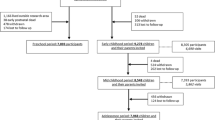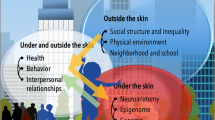Abstract
Adverse developmental exposures and pathologies of the social environment make vastly greater contributions to the leading health burdens in society than currently known genotypic information. Yet, while patients now commonly bring information on single alleles to the attention of their healthcare team, the former conditions are only rarely considered with respect to future health outcomes. This manuscript aims to integrate social environmental influences in genetic predictive models of disease risk. Healthcare providers must be educated to better understand genetic risks for complex diseases and the specific health consequences of societal adversities, to facilitate patient education, disease prevention, and the optimal care in order to achieve positive health outcomes for those with early trauma or other social disadvantage.

Similar content being viewed by others
References
23andMe, Inc. 2015. [Home page]. https://www.23andme.com/ancestry/. Accessed February 29, 2016.
Anglin, D.M., and D. Malaspina. 2008. Ethnicity effects on clinical diagnoses compared to best-estimate research diagnoses in patients with psychosis: A retrospective medical chart review. Journal of Clinical Psychiatry 69(6): 941–945.
Anonymous. 2009. What is health? The ability to adapt. The Lancet 373(9666): 781.
Benjamin, D.J., D. Cesarini, C.F. Chabris, et al. 2012. The promises and pitfalls of genoeconomics. Annual Review of Economics 4(4): 627–662.
Bernstein, E., and C.D. Allis. 2005. RNA meets chromatin. Genes and Development 19(14): 1635–1655.
Bongaarts, J. 2013. U.S. health in international perspective: Shorter lives, poorer health. Population and Development Review 39(1): 165–167.
Booij, L., M. Szyf, A. Carballedo, et al. 2015. DNA methylation of the serotonin transporter gene in peripheral cells and stress-related changes in hippocampal volume: A study in depressed patients and healthy controls. PLoS One 10(3):e0119061. doi:10.1371/journal.pone.0119061.
Bowers, M.E., and R. Yehuda. 2016. Intergenerational transmission of stress in humans. Neuropsychopharmacology 41(1): 232–244.
Brummett, B.H., M.A. Babyak, R. Jiang, et al. 2013. A functional polymorphism in the 5HTR2C gene associated with stress responses also predicts incident cardiovascular events. PloS One 8(12):e82781. doi:10.1371/journal.pone.0082781.
Bruni, A.C., M.E. Conidi, and L. Bernardi. 2014. Genetics in degenerative dementia: Current status and applicability. Alzheimer Disease and Associated Disorders 28(3): 199–205.
Cardon, L.R., and L.J. Palmer. 2003. Population stratification and spurious allelic association. The Lancet 361(9357): 598–604.
Charron, P. 2006. Clinical genetics in cardiology. Heart 92(8): 1172–1176.
Cirillo, E., G. Giardino, V. Gallo, et al. 2014. Intergenerational and intrafamilial phenotypic variability in 22q11.2 deletion syndrome subjects. BMC Medical Genetics 15: 1. doi:10.1186/1471-2350-15-1.
Conley, D., and E. Rauscher. 2013. Genetic interactions with prenatal social environment: Effects on academic and behavioral outcomes. Journal of Health and Social Behavior 54(1): 109–127.
Cook, C.J., and J.M. Fletcher. 2015. Understanding heterogeneity in the effects of birth weight on adult cognition and wages. Journal of Health Economics 41(C): 107–116.
Feldman, M.W., and R.C. Lewontin. 1975. The heritability hang-up. Science 190(4220): 1163–1168.
Fletcher, J.M. 2012. Why have tobacco control policies stalled? Using genetic moderation to examine policy impacts. PloS One 7(12), e50576. doi:10.1371/journal.pone.0050576.
Gibson, G. 2009. Decanalization and the origin of complex disease. Nature Reviews Genetics 10(2): 131–140.
Goldberg, A.D., C.D. Allis, and E. Bernstein. 2007. Epigenetics: A landscape takes shape. Cell 128(4): 635–638.
Goll, M.G., and T.H. Bestor. 2005. Eukaryotic cytosine methyltransferases. Annual Review of Biochemistry 74: 481–514.
Gordon, C. 1998. Canguilhem: Life, health and death: Special issue dedicated to Canguilhem. Economy and Society 27(2–3): 182–189.
Gourevitch, M.N., D. Malaspina, M. Weitzman, and L.R. Goldfrank. 2008. The public hospital in American medical education. Journal of Urban Health 85(5): 779–786.
Guo, G., T.J. Cai, R. Guo, H.Y. Wang, and K.M. Harris. 2010. The dopamine transporter gene, a spectrum of most common risky behaviors, and the legal status of the behaviors. PloS One 5(2):e9352. doi:10.1371/journal.pone.0009352.
Haeri, S., J. Williams, I. Kopeykina, et al. 2011. Disparities in diagnosis of bipolar disorder in individuals of African and European descent: A review. Journal of Psychiatric Practice 17(6): 394–403.
Hamer, D., and L. Sirota. 2000. Beware the chopsticks gene. Molecular Psychiatry 5(1): 11–13.
Hochberg, Z., R. Feil, M. Constancia, et al. 2011. Child health, developmental plasticity, and epigenetic programming. Endocrine Reviews 32(2): 159–224.
Johnson, W., and R.F. Krueger. 2005. Predictors of physical health: Toward an integrated model of genetic and environmental antecedents. Journals of Gerontology Series B: Psychology Sciences and Social Sciences 60(Special Issue 1): 42–52.
Kastrinos, F., and S. Syngal. (2011). Inherited colorectal cancer syndromes. Cancer Journal 17(6):405–15. doi:10.1097/PPO.0b013e318237e408.
Langley-Evans, S.C., and S. McMullen. 2010. Developmental origins of adult disease. Medical Principles and Practice 19(2): 87–98.
Maccari, S., H.J. Krugers, S. Morley-Fletcher, M. Szyf, and P.J. Brunton. 2014. The consequences of early-life adversity: Neurobiological, behavioural and epigenetic adaptations. Journal of Neuroendocrinology 26(10): 707–723.
Malaspina, D., C. Corcoran, K.R. Kleinhaus, et al. 2008. Acute maternal stress in pregnancy and schizophrenia in offspring: A cohort prospective study. BMC Psychiatry 8(1): 71. doi:10.1186/1471-244X-8-71.
McGowan, P.O., A. Sasaki, A.C. D’Alessio, et al. 2009. Epigenetic regulation of the glucocorticoid receptor in human brain associates with childhood abuse. Nature Neuroscience 12(3): 342–348.
McGrath, J.J., A.J. Hannan, and G. Gibson. 2011. Decanalization, brain development and risk of schizophrenia. Translational Psychiatry 1(6):e14. doi:10.1038/tp.2011.16.
Metzl, J., and H. Hansen. 2014. Structural competency: Theorizing a new medical engagement with stigma and inequality. Social Science & Medicine 103: 126–133.
Milekic, M.H., Y. Xin, A. O’Donnell, et al. 2015. Age-related sperm DNA methylation changes are transmitted to offspring and associated with abnormal behavior and dysregulated gene expression. Molecular Psychiatry 20(8): 995–1001.
Miller, T.W., J.T. Nigg, and R.L. Miller. 2009. Attention deficit hyperactivity disorder in African American children: What can be concluded from the past ten years? Clinical Psychology Review 29(1): 77–86.
Neigh, G.N., C.F. Gillespie, and C.B. Nemeroff. 2009. The neurobiological toll of child abuse and neglect. Trauma, Violence, & Abuse 10(4): 389–410.
Papp, B., and K. Plath. 2011. Reprogramming to pluripotency: Stepwise resetting of the epigenetic landscape. Cell Research 21(3): 486–501.
Roth, T.L., F.D. Lubin, A.J. Funk, and J.D. Sweatt. 2009. Lasting epigenetic influence of early-life adversity on the BDNF gene. Biological Psychiatry 65(9): 760–769.
Ruby, E., S. Polito, K. McMahon, M. Gorovitz, C. Corcoran, and D. Malaspina. 2014. Pathways associating childhood trauma to the neurobiology of schizophrenia. Frontiers in Psychological and Behavioral Sciences 3(1): 1–17.
Seppa, N. 2015. The mess that is stress. Science News 187(5): 18–23.
Tessarz, P., and T. Kouzarides. 2014. Histone core modifications regulating nucleosome structure and dynamics. Nature Reviews Molecular Cell Biology 15(11): 703–708.
Tung, J., and Y. Gilad. 2013. Social environmental effects on gene regulation. Cellular and Molecular Life Sciences 70(22): 4323–4339.
Vayena, E. 2015. Direct-to-consumer genomics on the scales of autonomy. Journal of Medical Ethics 41(4): 310–314.
Waddington, C.H. 1942. Canalization of development and the inheritance of acquired characters. Nature 150(3811): 563–565.
Waddington, C.H. 1959. Canalization of development and genetic assimilation of acquired characters. Nature 183(4676): 1654–1655.
Weaver, I.C., A.C. D'Alessio, S.E. Brown, I.C. Hellstrom, S. Dymov, S. Sharma, M. Szyf, and MJ. Meaney. 2007. The transcription factor nerve growth factor-inducible protein a mediates epigenetic programming: altering epigenetic marks by immediate-early genes. J Neurosci 27(7):1756–1768.
World Health Organization. 2001. Fact Sheet: The world health report 2001. Mental and neurological disorders. http://www.who.int/whr/2001/media_centre/en/whr01_fact_sheet1_en.pdf. Accessed February 29, 2016.
Yehuda, R., N.P. Daskalakis, L.M. Bierer, et al. 2015. Holocaust Exposure Induced Intergenerational Effects on FKBP5 Methylation. Biological Psychiatry. ePub ahead of print, August 12. doi:10.1016/j.biopsych.2015.08.005.
Author information
Authors and Affiliations
Corresponding author
Rights and permissions
About this article
Cite this article
Conley, D., Malaspina, D. Socio-Genomics and Structural Competency. Bioethical Inquiry 13, 193–202 (2016). https://doi.org/10.1007/s11673-016-9716-2
Received:
Accepted:
Published:
Issue Date:
DOI: https://doi.org/10.1007/s11673-016-9716-2




